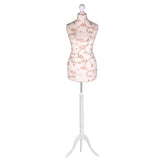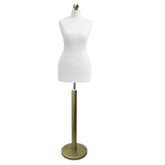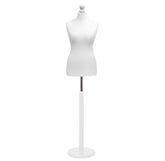Choosing Your Garment Rack with Cover
Feeling that familiar sense of dread when you look at an overflowing wardrobe? We’ve all been there. A garment rack with cover isn't just about finding a bit more hanging space; it’s a genuinely smart way to protect your clothes and bring a sense of order back to your home, keeping your favourite outfits safe from dust, sunlight, and moisture.
Why a Covered Garment Rack Is Your Wardrobe’s Best Friend
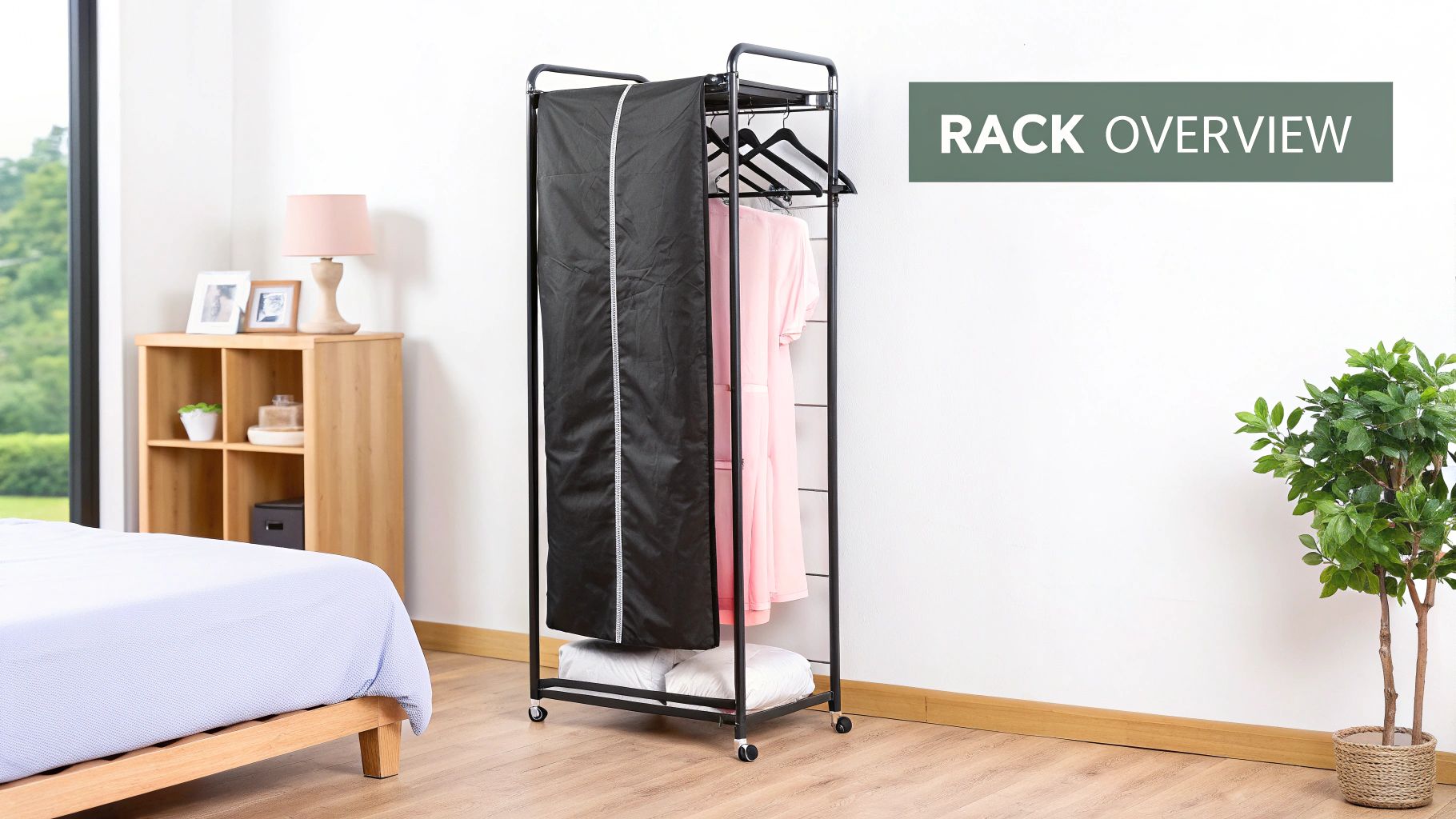
It’s best to think of a garment rack with a cover as more than a temporary fix. It's a proper piece of furniture that acts as a shield, preserving the colour and feel of your clothing. Delicate fabrics are kept safe from the elements, while your everyday essentials stay fresh and ready to go. It’s a simple addition that can genuinely transform chaos into calm.
Beyond just protecting what's inside, these racks offer fantastic flexibility. They can serve as a minimalist open wardrobe in a small flat, a dedicated home for out-of-season items like bulky winter coats, or even an instant guest closet when you have people staying over. The enclosed design tidies up what could be a messy collection of clothes into one neat unit, contributing to a much more organised room.
This move towards practical, space-saving furniture is part of a much bigger picture. The global garment racks market was valued at around USD 5.2 billion in 2023, and it's expected to keep growing. Here in the UK, we're seeing huge demand in cities like London and Manchester, where smaller living spaces and a taste for minimalist design are driving the need for smarter storage. People are turning away from traditional, heavy wardrobes and looking for options that better fit their lives. You can find out more about the growth of the garment rack market.
Key Benefits at a Glance
A garment rack with a cover brings a few immediate wins that go well beyond just giving you another rail to hang things on. Understanding these benefits makes it clear why they've become such a popular choice for modern homes.
- Complete Garment Protection: The cover creates a barrier against everything that can ruin clothes over time—dust, pet hair, moisture, and fading from sunlight. It really does extend the life of your garments.
- Enhanced Organisation: By keeping your clothes concealed, it instantly reduces visual clutter. This creates a much tidier, more streamlined look, which is perfect for open-plan living or bedrooms that lack built-in storage.
- Versatile Storage Solution: It’s the perfect spot for storing seasonal clothing, setting up a temporary wardrobe during home renovations, or simply managing the overflow from your main closet.
Why a Cover Makes All the Difference

It’s easy to look at an open garment rail and dismiss the cover as just another add-on. But in reality, it’s the single most important feature that elevates a simple storage rack into a proper wardrobe solution. Think of it as a personal bodyguard for your clothing, offering a level of protection that an open rail simply can't provide.
Consider all the everyday things your clothes face. Dust, pet hair, and airborne allergens inevitably settle on any exposed surface. A garment rack with a cover creates a self-contained environment, keeping your favourite outfits clean and ready to wear at a moment's notice. This is especially vital for delicate materials like silk or wool, which can suffer from long-term exposure.
Then there's the sun. Direct sunlight will fade even the most vibrant colours over time, leaving them looking dull and worn. The cover acts as a crucial UV shield, preserving the original look and feel of your garments. This is a game-changer for items you don't wear often, like seasonal coats or special-occasion outfits, ensuring they stay in perfect condition while tucked away.
From Clutter to Calm
Beyond sheer protection, a cover brings a huge organisational advantage: it completely hides visual noise. An open rack, loaded with a jumble of different colours, patterns, and textures, can make even the most organised room feel busy and cluttered. By contrast, the clean, uniform exterior of a covered rack instantly calms the space, creating a sleek, streamlined appearance.
A covered garment rack doesn’t just store your clothes; it curates your space. By hiding the contents, it allows the room to feel more intentional and less like a temporary storage area.
This idea of concealing items to create a tidier look is a core principle in both home organisation and professional retail. If you're curious about how visual presentation can transform a space, exploring some essential visual merchandising guidelines offers some great insights into building an organised and appealing environment.
Instant Wardrobe Solutions
The sheer versatility of a covered rack is where it truly shines, adapting to all sorts of needs around the home. It essentially becomes an instant, self-contained closet wherever you need one.
- Guest Room Ready: Immediately create a welcoming spot for visitors to hang their clothes, keeping them separate, protected, and dust-free.
- Seasonal Storage Hub: Dedicate a rack to out-of-season items, like bulky winter coats or light summer dresses, which frees up valuable space in your main wardrobe.
- Pop-Up Changing Area: When placed strategically or paired with a screen, it can even create a private changing area for events, photoshoots, or shared living spaces.
At the end of the day, the cover is what turns a basic rail into a functional, protective, and genuinely good-looking piece of furniture. It’s the defining feature for anyone who's serious about looking after their clothes and keeping their home organised.
Finding the Right Materials and Build Quality
The real, long-term value of a garment rack with a cover comes down to one thing: what it’s made of. Think about it – you wouldn't use a paper bag to carry your weekly shop. In the same way, choosing the right materials for your rack ensures it can handle your wardrobe without buckling under the pressure.
You've got two main components to consider: the frame and the cover. Getting the right combination is the key to making a smart purchase that lasts.
The Frame: Strength and Stability
The frame is the skeleton of your storage setup, and its material is what determines its strength. If you’re planning on hanging heavy-duty items like winter coats or a full rail of denim, then steel is the undisputed champion. It offers serious strength and durability, so you can be confident your rack will stay stable and secure, no matter how much you load it up.
For lighter use, aluminium frames are a great alternative. They're much lighter than steel and often a bit easier on the wallet, making them perfect for shirts, dresses, and blouses. Their portability also makes them a brilliant choice if you move house often or need a temporary storage solution. You can find a great selection of choices for a portable clothing rack that really shows how different materials impact how you can use them.
Of course, if looks are your priority, a wooden frame can blend beautifully with your home décor, offering a much warmer and more traditional feel. Just bear in mind that they typically can't support as much weight as their metal cousins.
The Cover: Protection and Practicality
The cover is the protective skin for your clothes, and the fabric you choose directly affects how well it does its job. The two most common options you'll come across are non-woven fabric and clear PVC, and they each serve a very different purpose.
- Non-Woven Fabric: This is by far the most popular choice for long-term storage, and for good reason. It's breathable, which allows air to circulate and prevents that musty smell from developing when clothes are packed away. It’s the perfect material for stashing seasonal items out of sight for months at a time.
- Clear PVC or PEVA: A clear plastic cover, on the other hand, is all about easy access. It lets you see your entire collection at a glance, so you can find exactly what you're looking for without unzipping a thing. The downside? Plastic isn't breathable and can trap moisture, so it's best reserved for short-term use in dry environments.
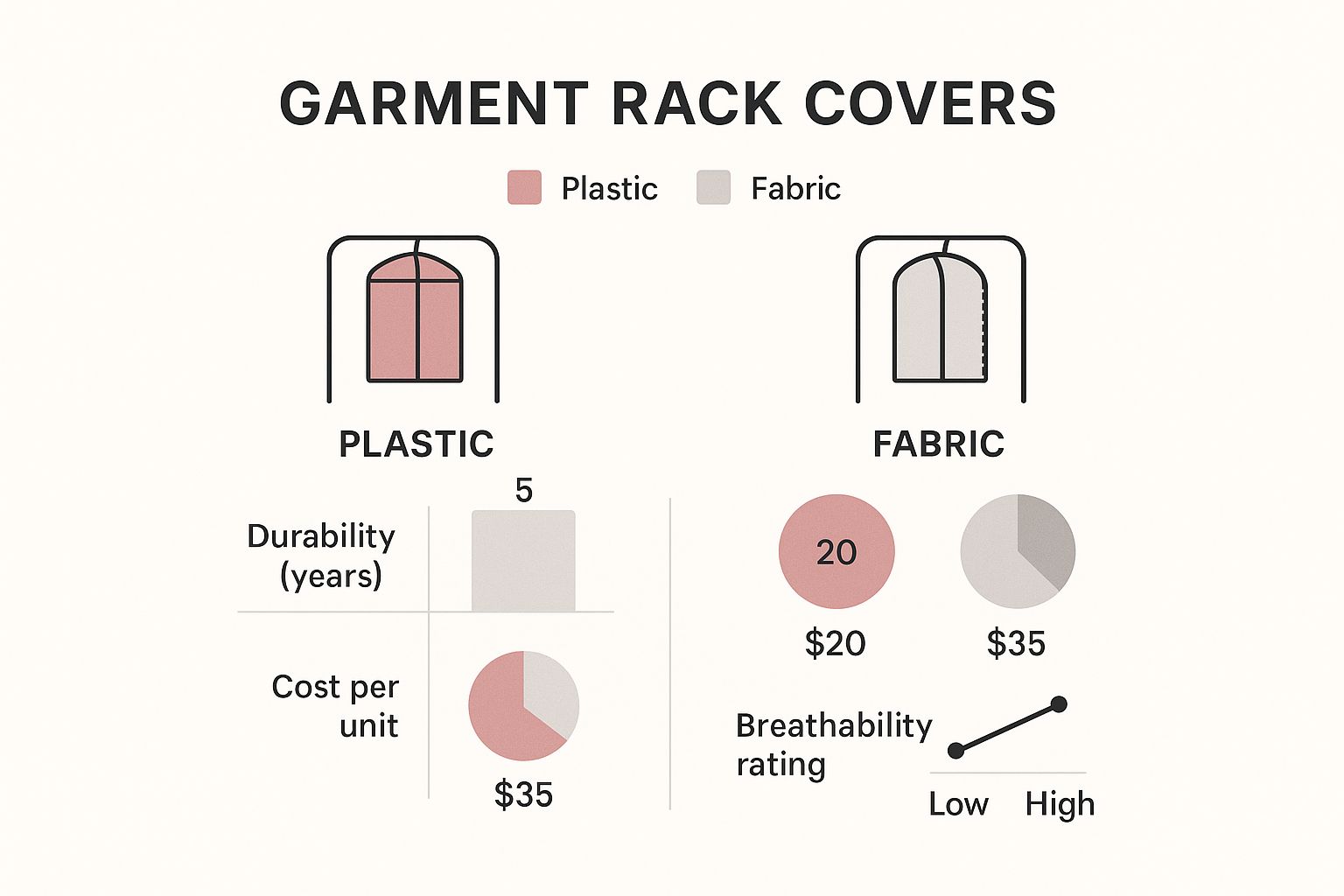
When you look at the comparison, it’s clear that fabric covers are the better long-term investment due to their superior durability and breathability. Plastic, however, offers a budget-friendly option where high visibility is the top priority.
Comparing Garment Rack Materials
Choosing the right materials for your rack's frame and cover is crucial. This table breaks down the most common options to help you decide which one best fits your needs, whether you're prioritising strength, style, or the long-term safety of your clothes.
| Material Type | Best For | Pros | Cons |
|---|---|---|---|
| Steel Frame | Heavy-duty use, large wardrobes, winter coats. | Exceptionally strong and durable, offers maximum stability. | Heavier, can be more expensive. |
| Aluminium Frame | Lighter clothing, temporary storage, frequent moves. | Lightweight, portable, often more affordable. | Less durable than steel, lower weight capacity. |
| Wooden Frame | Integrating with home décor, aesthetic appeal. | Stylish and warm appearance. | Lower weight capacity, can be susceptible to moisture. |
| Non-Woven Cover | Long-term or seasonal storage. | Breathable, prevents mustiness, durable. | Opaque, you can't see the contents inside. |
| PVC/PEVA Cover | Quick access and short-term storage. | Transparent for easy viewing, budget-friendly. | Not breathable, can trap moisture and damage clothes. |
Ultimately, the best choice depends on what you're storing and for how long. A sturdy steel frame with a breathable fabric cover is ideal for serious, long-term storage, while a lightweight aluminium and PVC combo might be perfect for a temporary setup in a spare room.
Spotting Quality Construction
Beyond the main materials, it's the small details in the build quality that often make the biggest difference. Take a close look at the connectors and joints. Are they flimsy plastic or reinforced? Better yet, are they metal? Sturdier connectors are a clear sign of a build that won't wobble over time.
If the rack has wheels, check what they're made of. Hard-wearing plastic or rubber is a good sign, and a locking mechanism is essential to keep the whole unit stable and prevent it from rolling away. A strong, smooth-gliding zipper and solid castors might seem like minor features, but they are the hallmarks of a product that has been designed to last.
Matching the Rack Size to Your Space
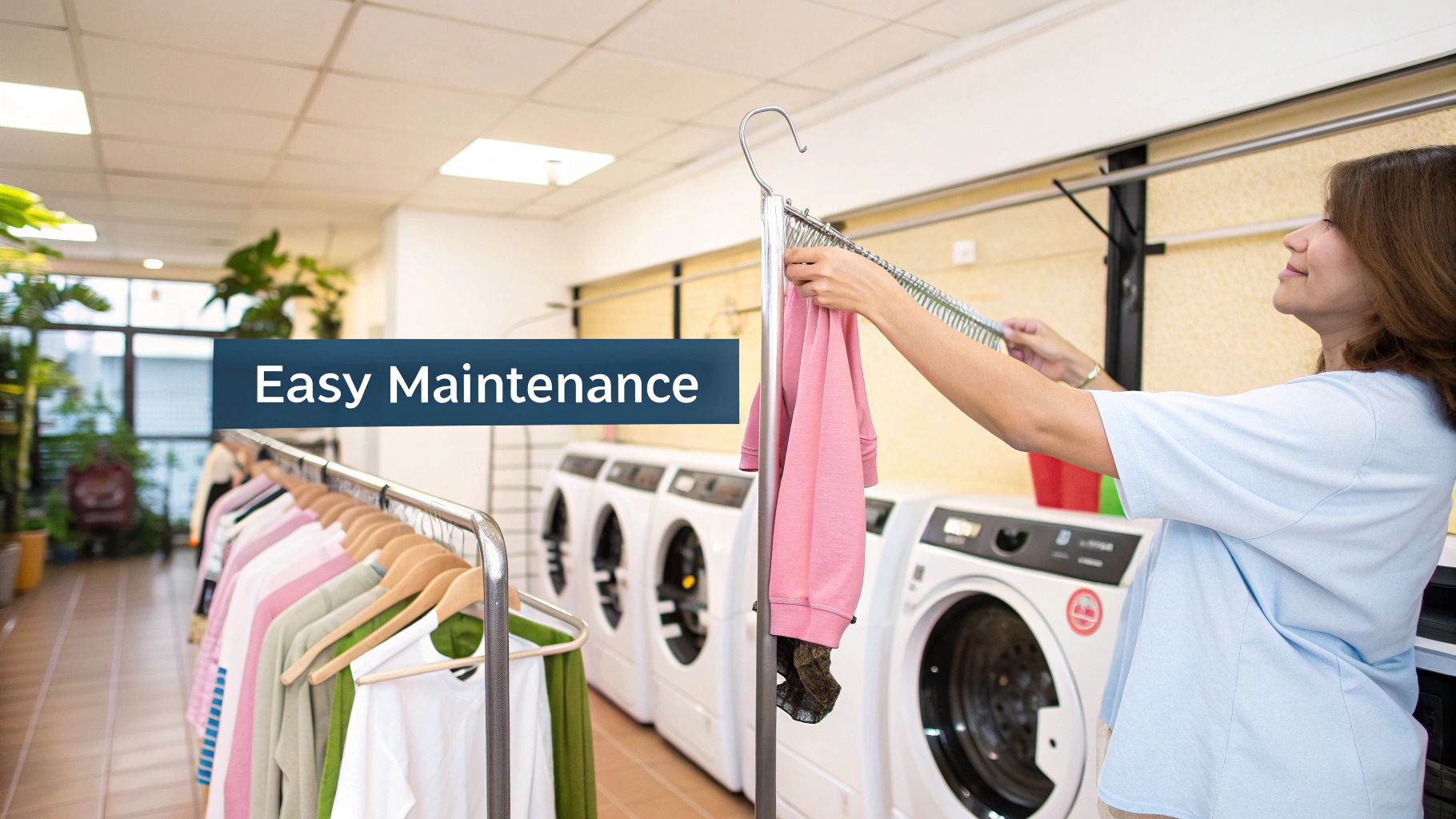
Choosing a garment rack with a cover isn't just about storage; it’s about finding a piece that fits your room as naturally as a well-made coat fits your shoulders. Get it wrong, and you've got an oversized rack cramping your style or a tiny one that’s completely swamped. The goal is to hit that sweet spot between the space you have and the storage you actually need.
So, before you start adding things to your basket, reach for a tape measure. This is the most important first step. Carefully measure the width, depth, and particularly the height of the area where the rack will live. And remember to leave a little breathing room around it—you'll need space to walk past and to open the cover without a struggle.
Measure Your Space and Your Wardrobe
It's easy to focus on floor space, but don't forget to look up. The height of the rack is crucial. If you own long coats, maxi dresses, or elegant gowns, you'll need a taller frame or an adjustable rail. This simple check ensures your clothes hang properly, preventing them from dragging on the floor and getting creased.
Think about the sheer volume of clothes you need to hang, too. This practical need for better organisation is a big reason why the home storage market has taken off.
In 2024, the global market for garments display racks hit a value of USD 5.2 billion, and it's set to keep growing. Here in the UK, the demand for clever storage in smaller city homes has made adjustable and covered racks incredibly popular.
Choosing the Right Design for Your Needs
With your measurements in hand, you can start thinking about the design that will work best for you. There are two main types, and each one suits a different kind of wardrobe. Understanding the difference is key to making a smart choice. If you want to dive deeper, you can find detailed size guides for storage options that can help you visualise what might work.
-
Single-Rail Racks: The classic. These are brilliant for smaller clothing collections or for putting together a curated capsule wardrobe. Their simple, clean lines make them a great fit for guest rooms, hallways, or as a handy overflow for your main closet.
-
Double-Rail Racks: Got a lot of clothes? A double-rail rack is your best friend. It literally doubles your hanging space without taking up any more of your floor. They're perfect for couples sharing a room or for keeping your work and weekend wardrobes separate.
Essential Features to Look For
Beyond just the rails, a few clever features can make a huge difference to how useful your rack is. Think about how you’ll use it every day to figure out which extras are worth having. For a closer look at how different designs can meet specific needs, take a look at our comprehensive guide on https://www.displayguru.co.uk/blogs/news/clothing-display-racks.
Rails with adjustable height are a game-changer, giving you the flexibility to hang anything from blouses to trench coats. Lockable wheels are another must-have, making it easy to move the rack for a good clean but keeping it firmly in place the rest of the time. Many racks also come with built-in shelves at the top or bottom, giving you a perfect spot for shoes, bags, or storage boxes.
Assembly and Care for Long-Lasting Use
You’ve found the perfect garment rack with a cover for your space—great! Now, let’s talk about making sure it stands the test of time. Getting the assembly right from the start and keeping up with a bit of simple care are the two secrets to getting years of reliable use from your investment.
Proper setup is the bedrock of a stable, long-lasting rack. Before you even think about putting pieces together, take a moment to lay everything out and cross-reference it with the parts list. It’s a small step, but it saves a world of headache later on and confirms you have everything you need.
If your rack arrived flat-packed, the assembly can feel a bit like adult LEGOs, but with higher stakes if a piece isn’t quite right. For a bit of guidance on navigating these kinds of builds, a good step-by-step guide for IKEA furniture assembly can offer some really useful principles for a solid setup.
A Solid Foundation: The Key to Stability
As you construct the frame, focus on making every connection as secure as possible. Whether it uses push-pins, screws, or snap-on parts, give each joint a firm wiggle to test its integrity. A loose connection is almost always the culprit behind a wobbly rack, which puts unnecessary stress on the whole structure.
Once it's built, the next trick is to master the art of load balancing. This might just be the most important factor in its long-term health.
A classic mistake is piling all the heavy items—like winter coats and bulky denim—onto one end of the rail. This throws the whole thing off balance, straining the frame and creating a genuine tipping risk, particularly with taller models.
Make it a habit to distribute heavier garments evenly across the rail. This keeps the rack’s centre of gravity stable and stops it from leaning or buckling under the weight. If you know you have a hefty wardrobe, it's worth looking into models built for the job. Our guide on choosing a heavy-duty clothing rack dives into options designed to handle serious capacity.
Simple Maintenance for Lasting Protection
Looking after your garment rack and its cover is surprisingly simple, but the impact is huge. A little bit of attention now and then will keep it working perfectly and looking sharp.
Essential Care Checklist:
- Wipe Down the Frame: Once a month or so, give the metal or wooden frame a quick wipe with a dry or slightly damp cloth. This gets rid of dust before it has a chance to build up and transfer onto your clothes.
- Clean the Cover: Most non-woven fabric covers just need a spot-clean with a damp cloth and a touch of mild soap. It's best to avoid the washing machine, as it can damage the material. For PVC covers, a simple wipe is all it takes.
- Check Wheels and Joints: If your rack is on wheels, check them every so often for tangled hair or thread that could stop them from rolling smoothly. At the same time, give any screws or connections a quick check to ensure they haven't worked themselves loose.
Common Questions About Garment Racks
When you start looking for a new storage solution, a few questions always pop up. It's no different when you're considering a garment rack with a cover. We've pulled together the most common queries to give you clear, straightforward answers, helping you feel confident in your choice.
Getting to grips with the practical limits and features of these racks is key. It ensures you find one that perfectly fits your needs, whether you're trying to tame a heavy winter wardrobe or store delicate seasonal items properly.
How Much Weight Can a Garment Rack with a Cover Actually Hold?
This is probably the number one question, and honestly, the answer varies massively from one model to another. A basic, lightweight rack might only support around 15-20 kg. That's perfectly fine for a handful of shirts and dresses, but it’s not going to cut it for bulky winter coats or a rail full of jeans.
At the other end of the scale, you have heavy-duty steel racks that can comfortably hold over 100 kg. These are the workhorses of the storage world, built for serious capacity. If you plan on loading the rail up, this is what you need to be looking for. Always double-check the manufacturer’s specified weight capacity before you buy to avoid a bent rail or, worse, a total collapse.
A crucial tip for safety and keeping your rack in good shape is to spread the weight evenly across the rail. Piling all your heavy items at one end puts a huge strain on the frame and can make even the sturdiest rack a tipping hazard.
This idea of a balanced display is just as important in a shop as it is at home. If you're curious about how the pros do it for stability and visual impact, our article on effective clothing display stands has some brilliant insights.
Are the Fabric Covers Machine Washable?
For the most part, no. The non-woven fabric covers that come with most garment racks just aren't built for the rough and tumble of a washing machine. Throwing one in the wash could cause it to shrink, tear, or lose its protective qualities altogether.
The best way to keep the cover looking fresh is with a little light maintenance. For everyday dust, a quick once-over with a lint roller or a vacuum with a brush attachment does the trick. If you spot a small mark, spot cleaning is definitely the way to go.
Simple Spot Cleaning Steps:
- Mix a tiny amount of mild soap with some cool water.
- Dampen a clean cloth with the soapy mixture – make sure it’s not sopping wet.
- Gently dab at the stain until it starts to lift.
- Use a second cloth, dampened with plain water, to wipe away any soap residue.
- Let the cover air dry completely before putting it back on.
If super-easy cleaning is a deal-breaker for you, look for a rack with a vinyl (PVC) or canvas cover. These materials can usually just be wiped down with a damp cloth.
Can I Use a Covered Rack for Long-Term Storage?
Absolutely! In fact, this is one of their biggest selling points. They're a fantastic solution for stashing away seasonal clothes, like bulky ski jackets in the summer or light dresses in the winter, freeing up valuable space in your main wardrobe.
The type of cover you choose is really important for long-term storage, though. A breathable fabric cover is your best bet. It allows air to circulate, which is essential for stopping that musty smell that can build up when clothes are packed away for months.
Plastic covers are great for short-term dust protection, but they can trap moisture, especially if you live somewhere humid. Over time, that trapped moisture can lead to mildew or even damage delicate fabrics. A final pro tip: always make sure your clothes are completely clean and bone-dry before you store them for the season to keep them in perfect condition.
At Display Guru, we provide a wide range of durable and stylish garment racks designed to meet the needs of both home organisers and retail professionals. Explore our collection and find the perfect storage solution today at https://www.displayguru.co.uk.


